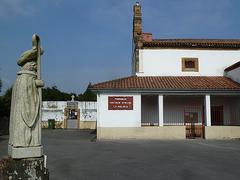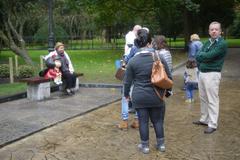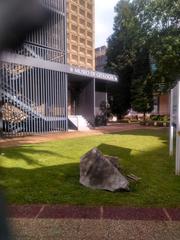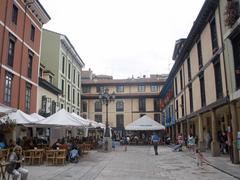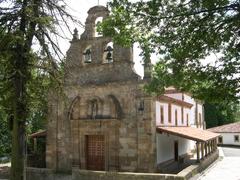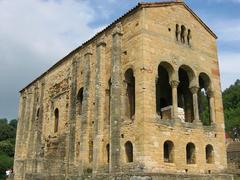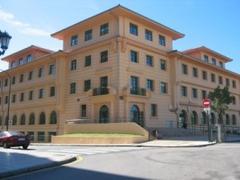
Comprehensive Guide to Visiting Fuente de Foncalada, Oviedo City, Spain
Date: 23/07/2024
Introduction
Nestled in the heart of Oviedo, Spain, the Fuente de Foncalada is an ancient fountain that offers a unique glimpse into the advanced engineering and rich history of the early medieval period. Constructed during the reign of King Alfonso III of Asturias in the 9th century, this fountain is not just a source of clean water but a symbol of the city’s historical and cultural heritage. Known for its unique architectural design, the Fuente de Foncalada represents a remarkable example of early medieval civil engineering. The fountain was built to provide a reliable source of clean water to the inhabitants of Oviedo, which was then the capital of the Kingdom of Asturias (UNESCO). Over the centuries, this historical monument has been preserved and recognized for its exceptional value, earning a designation as a UNESCO World Heritage Site in 1998. This guide aims to provide a comprehensive overview of the Fuente de Foncalada, covering its history, architectural features, cultural significance, and essential visitor information to help you make the most of your visit to this hidden gem in Oviedo.
Table of Contents
- Introduction
- Origins and Construction
- Architectural Features
- Historical Significance
- Preservation and Recognition
- Archaeological Discoveries
- Cultural Impact
- Modern-Day Relevance
- Visitor Information
- FAQ Section
- Conclusion and Call to Action
Origins and Construction
The Fuente de Foncalada, located in Oviedo, Spain, is a remarkable example of early medieval civil engineering. Constructed during the reign of King Alfonso III of Asturias (866-910 AD), this ancient fountain is a testament to the advanced hydraulic engineering skills of the time. The structure was built to provide a reliable source of clean water to the inhabitants of Oviedo, which was then the capital of the Kingdom of Asturias. The fountain’s name, “Foncalada,” is derived from the Latin “Fontem Calatam,” meaning “hidden fountain,” indicating its significance and perhaps its somewhat concealed location.
Architectural Features
The Fuente de Foncalada is notable for its unique architectural design, which includes a rectangular stone basin covered by a barrel-vaulted stone canopy. The canopy is supported by robust stone walls, and the entire structure is built using large, precisely cut stone blocks. This construction technique reflects the influence of Roman engineering, which was prevalent in the region during the early medieval period. The fountain’s design also includes a carved cross of Victory, a symbol associated with the Asturian monarchy, emphasizing its royal patronage and religious significance.
Historical Significance
The Fuente de Foncalada holds immense historical significance as it is one of the few remaining examples of civil architecture from the early medieval period in Spain. Its construction during the reign of Alfonso III highlights the importance of public infrastructure in the Asturian kingdom. The fountain not only provided a vital water source but also served as a symbol of the king’s commitment to the welfare of his subjects. The presence of the Victory Cross further underscores the intertwining of religious and royal authority during this period.
Preservation and Recognition
Over the centuries, the Fuente de Foncalada has undergone various restoration efforts to preserve its structural integrity and historical value. In 1998, it was designated a UNESCO World Heritage Site as part of the “Monuments of Oviedo and the Kingdom of the Asturias” listing (UNESCO). This recognition underscores the fountain’s importance as a cultural and historical landmark. The UNESCO listing has also helped to ensure ongoing preservation efforts and increased awareness of the site’s significance.
Archaeological Discoveries
Archaeological excavations around the Fuente de Foncalada have revealed additional insights into its historical context. These excavations have uncovered remnants of ancient water channels and other infrastructure that supported the fountain’s operation. The findings suggest that the fountain was part of a more extensive water management system, highlighting the advanced engineering capabilities of the Asturian kingdom. These discoveries have provided valuable information about the daily lives of the inhabitants of Oviedo during the early medieval period.
Cultural Impact
The Fuente de Foncalada has had a lasting cultural impact on the city of Oviedo and the broader region. It is a symbol of the city’s rich historical heritage and a testament to the ingenuity of its early inhabitants. The fountain is also a popular tourist attraction, drawing visitors from around the world who are interested in exploring its historical and architectural significance. The site is often included in guided tours of Oviedo, providing visitors with a deeper understanding of the city’s medieval past.
Modern-Day Relevance
Today, the Fuente de Foncalada continues to be a vital part of Oviedo’s cultural landscape. It serves as a reminder of the city’s historical roots and the enduring legacy of the Asturian kingdom. The fountain is also a focal point for local events and celebrations, further cementing its role as a cherished landmark. Efforts to preserve and promote the Fuente de Foncalada ensure that future generations can appreciate its historical and cultural significance.
Visitor Information
For those planning to visit the Fuente de Foncalada, it is conveniently located in central Oviedo and is open to the public year-round with no admission fee. The best time to visit is during daylight hours, and guided tours are available for a more in-depth experience. Nearby attractions include the Oviedo Cathedral and the Church of San Julián de los Prados, making it easy to plan a full day of historical exploration. The site is wheelchair accessible, and there are several nearby cafes and restaurants to enjoy a meal after your visit.
FAQ Section
Q: What are the visiting hours for Fuente de Foncalada?
A: The Fuente de Foncalada is open year-round during daylight hours.
Q: Is there an admission fee to visit Fuente de Foncalada?
A: No, there is no admission fee to visit the Fuente de Foncalada.
Q: Can I book a guided tour of Fuente de Foncalada?
A: Yes, guided tours are available and can be booked in advance through the official tourism website of Oviedo.
Q: What are some nearby attractions to Fuente de Foncalada?
A: Nearby attractions include the Oviedo Cathedral and the Archaeological Museum of Asturias.
Conclusion and Call to Action
In summary, the Fuente de Foncalada is a must-visit historical landmark that offers a unique glimpse into Oviedo’s rich past. Its construction during the reign of Alfonso III highlights the importance of public infrastructure in the Asturian kingdom, serving as a symbol of the king’s commitment to the welfare of his subjects. The fountain’s architectural ingenuity, historical significance, and cultural impact make it a vital part of Oviedo’s heritage. Recognized as a UNESCO World Heritage Site, the Fuente de Foncalada continues to be a focal point for both locals and tourists, drawing visitors from around the world interested in exploring its historical and architectural significance (UNESCO). Efforts to preserve and promote this remarkable monument ensure that future generations can appreciate its historical and cultural value. Whether you’re a history enthusiast, an architecture aficionado, or simply a curious traveler, a visit to the Fuente de Foncalada promises to be an enriching and memorable experience. Don’t forget to download our mobile app Audiala for more travel tips and updates on historical sites. Follow us on social media to stay updated on new posts and guides.
References
- Visiting Fuente de Foncalada - History, Tickets, and Tips for Exploring Oviedo’s Hidden Gem, 2024, UNESCO
- Exploring Fuente de Foncalada - Visiting Hours, Tickets, and Historical Insights, 2024, UNESCO
- Discover Fuente de Foncalada - Visiting Hours, Tickets, and Historical Insights in Oviedo, 2024, UNESCO





